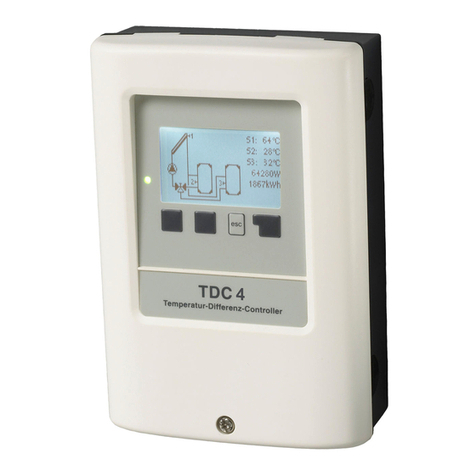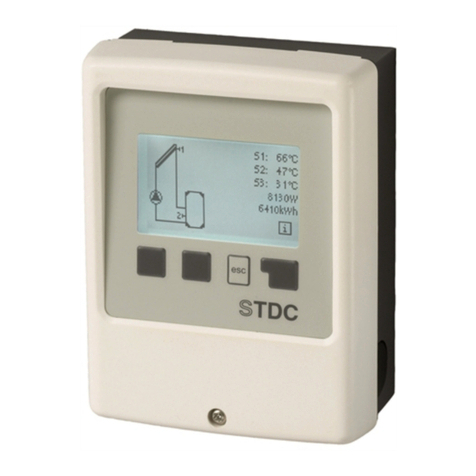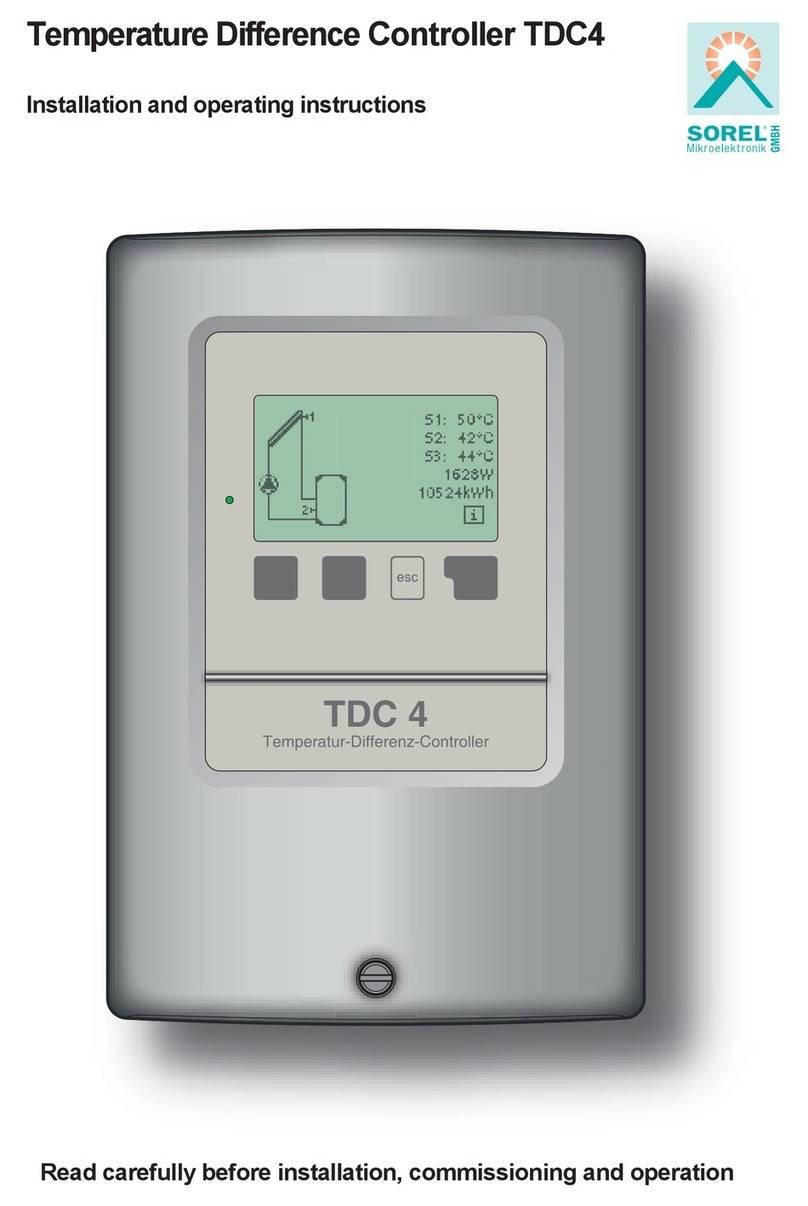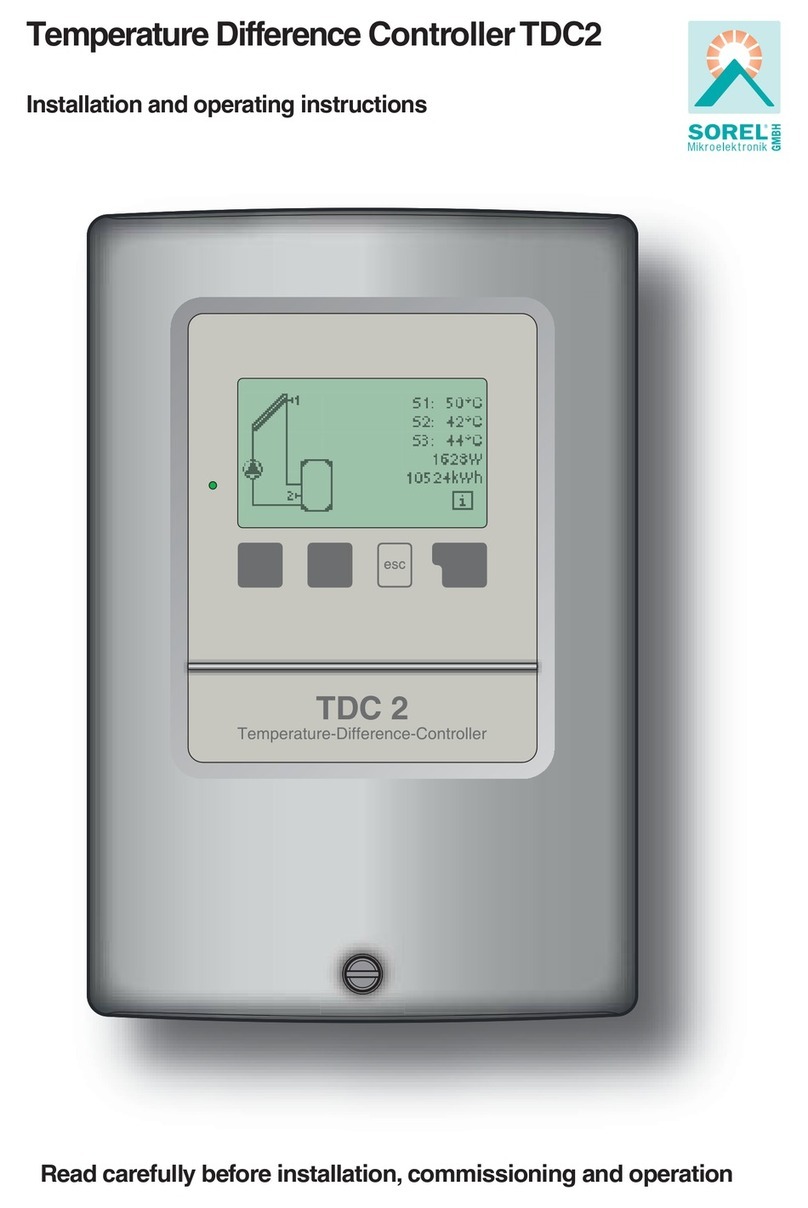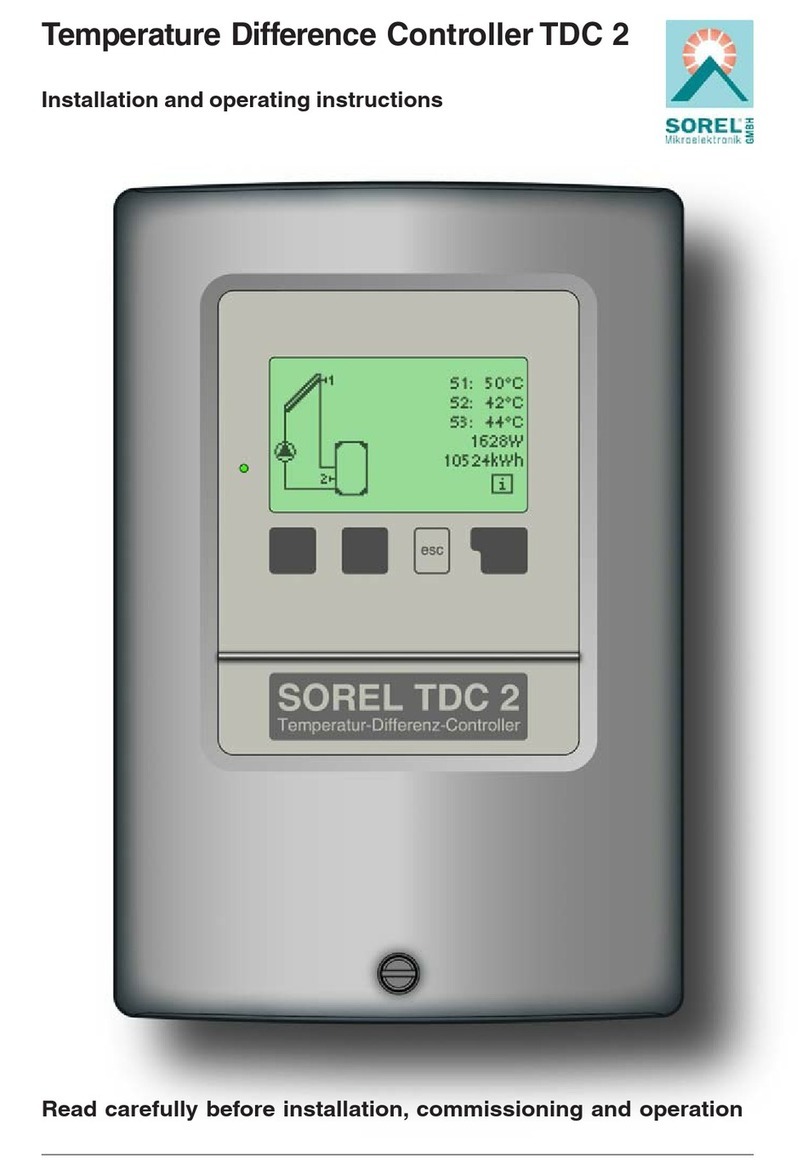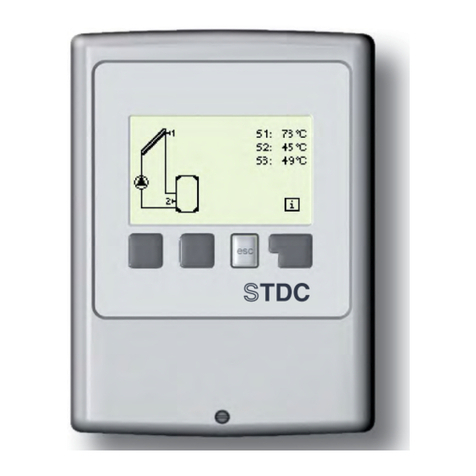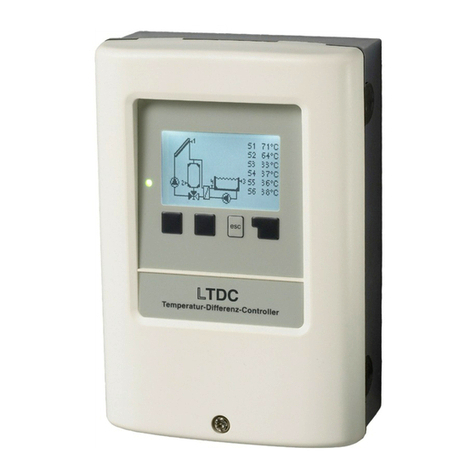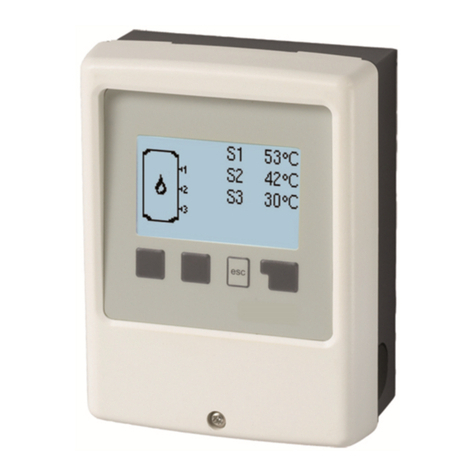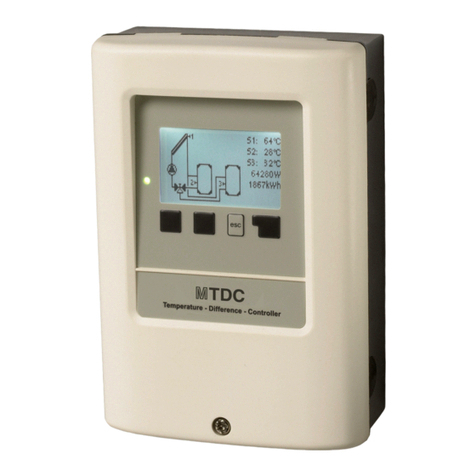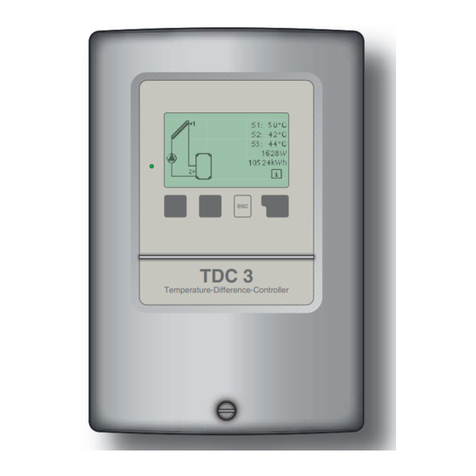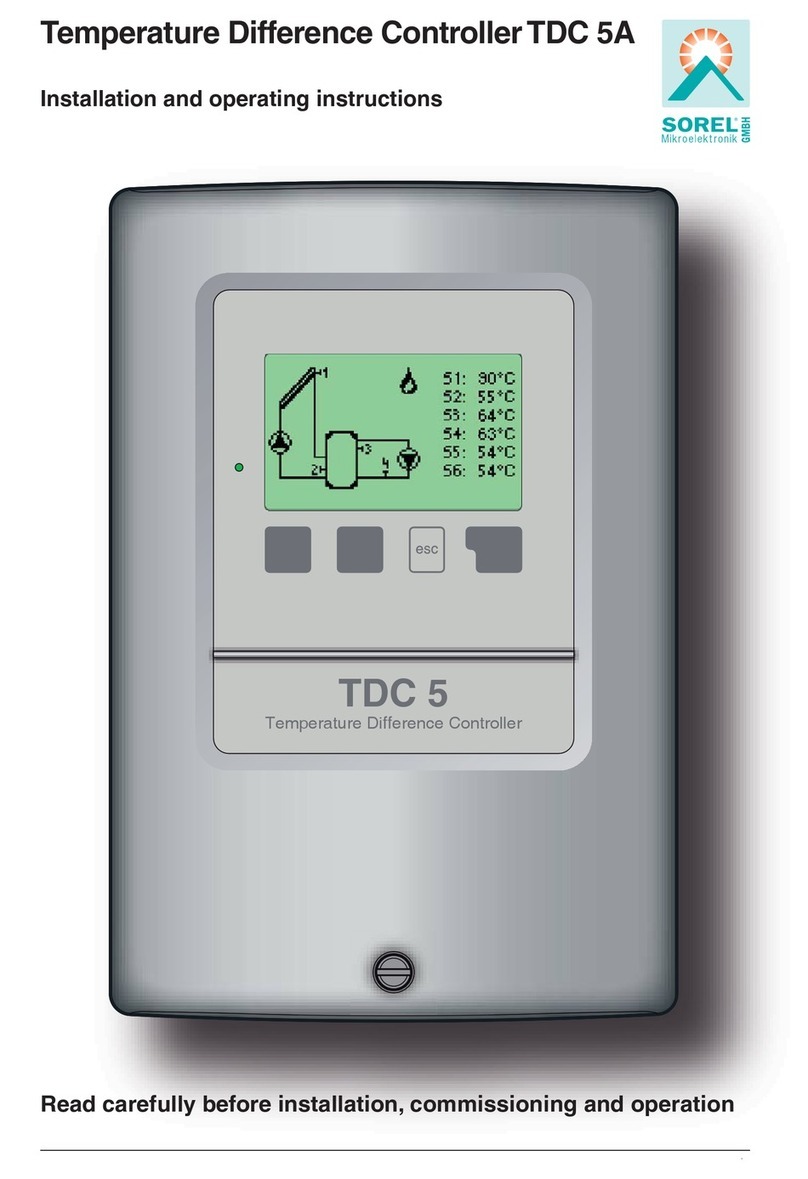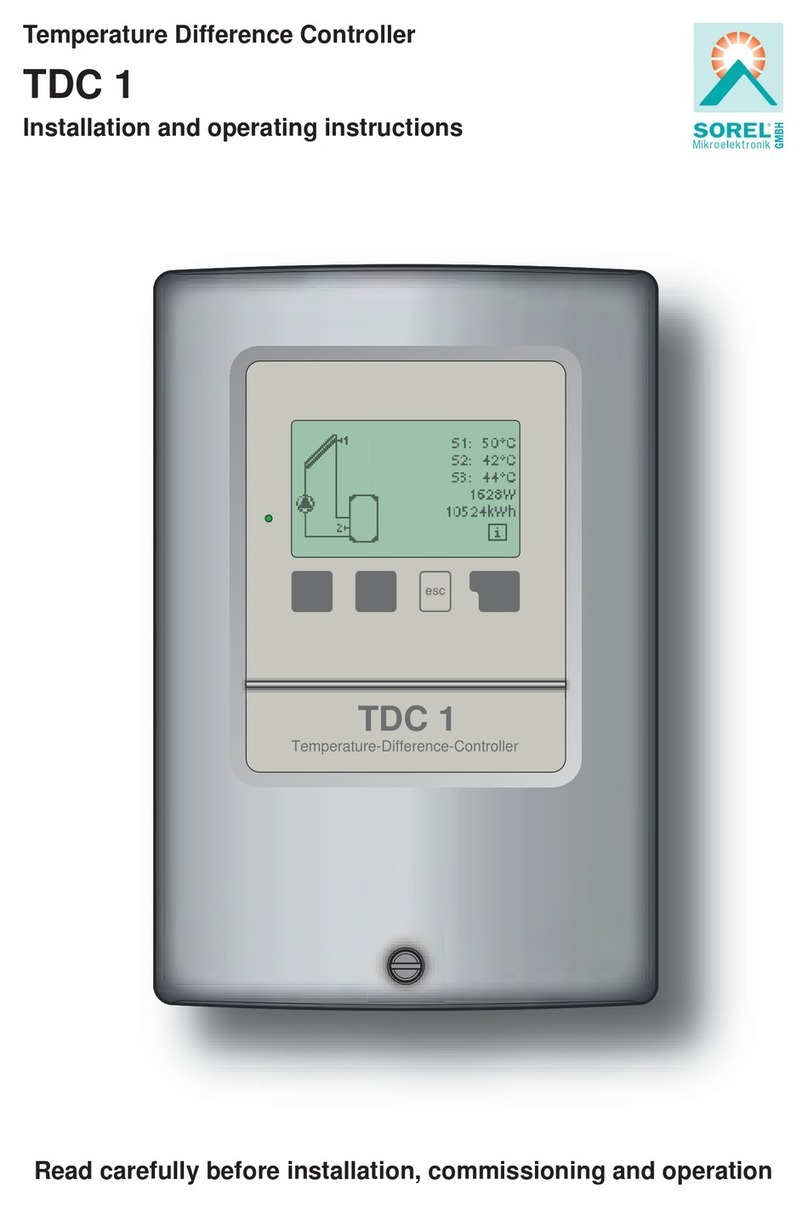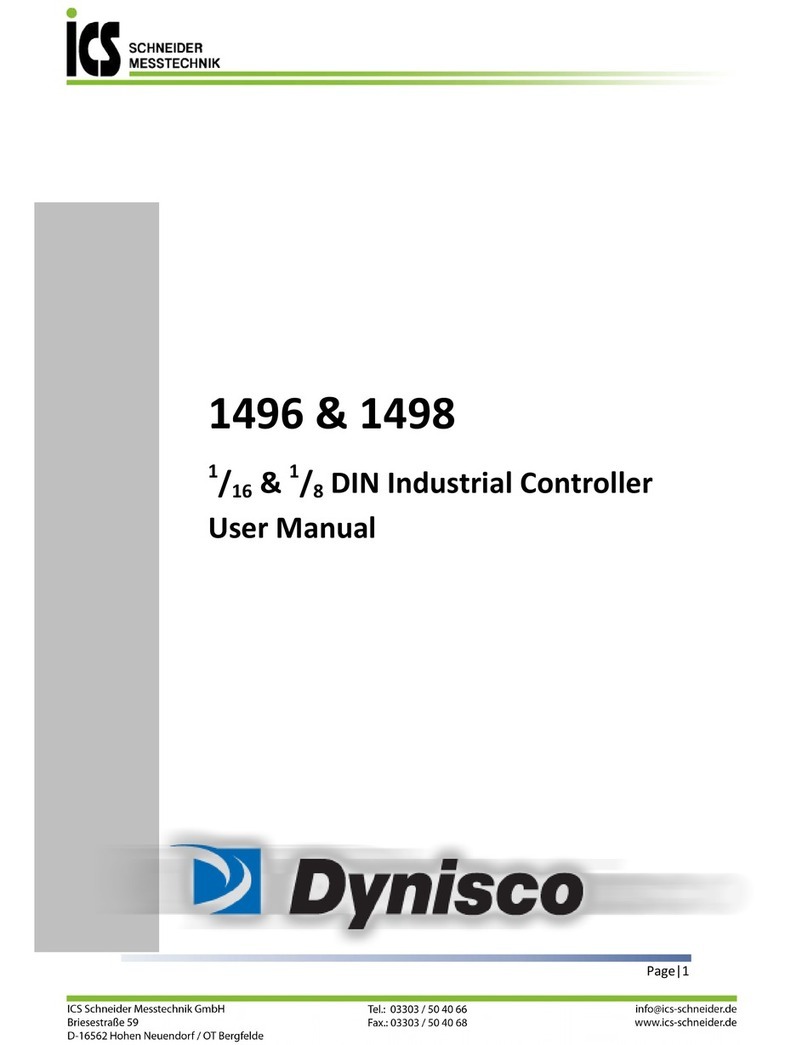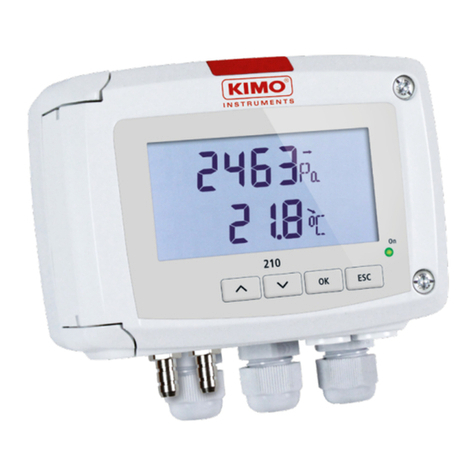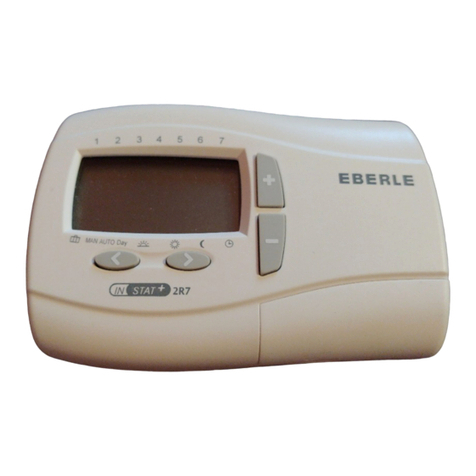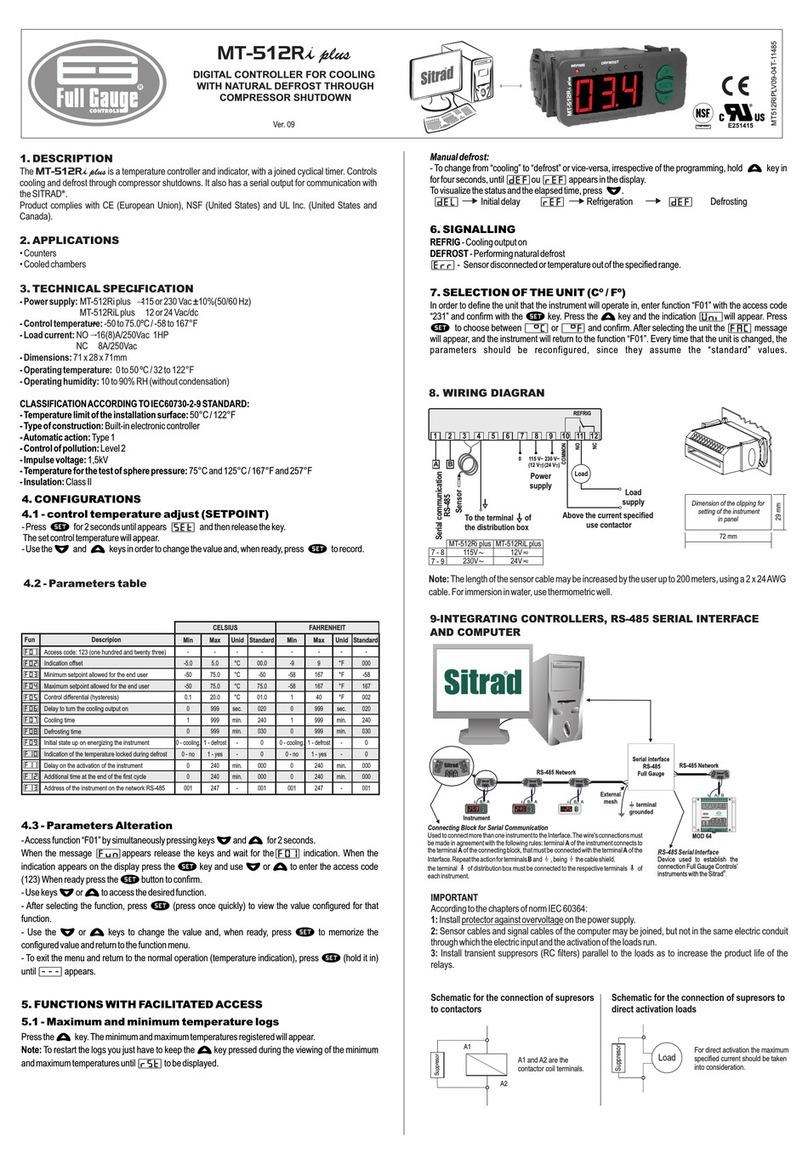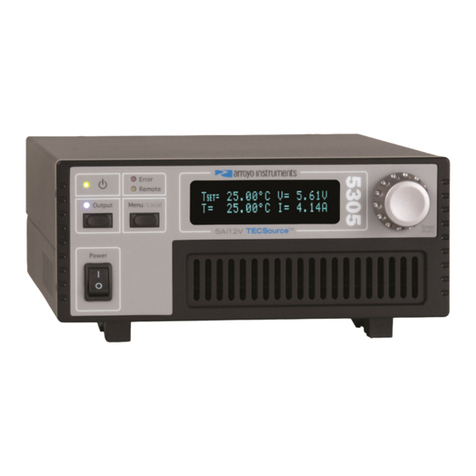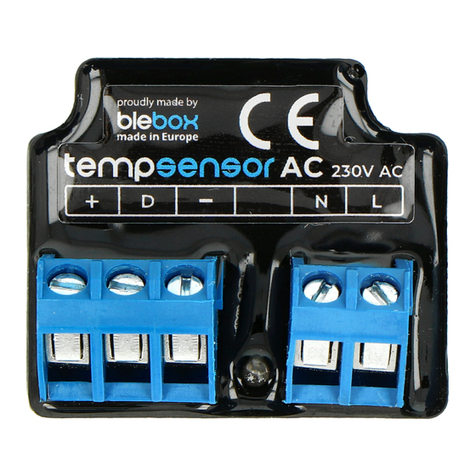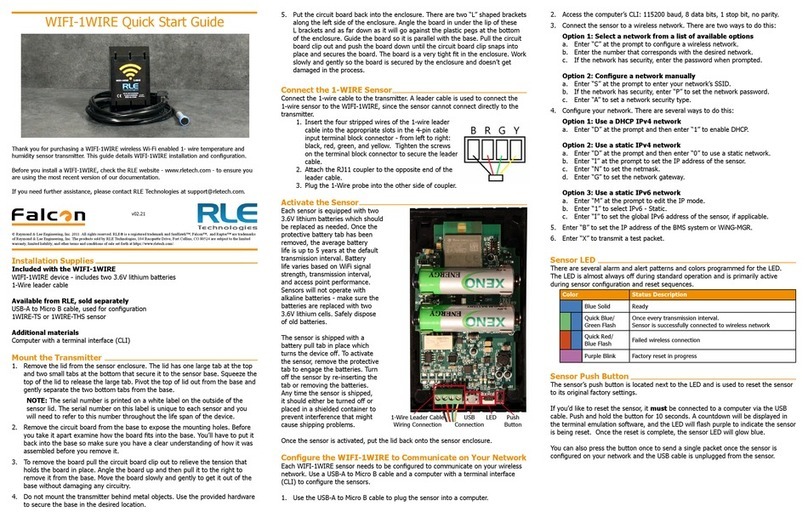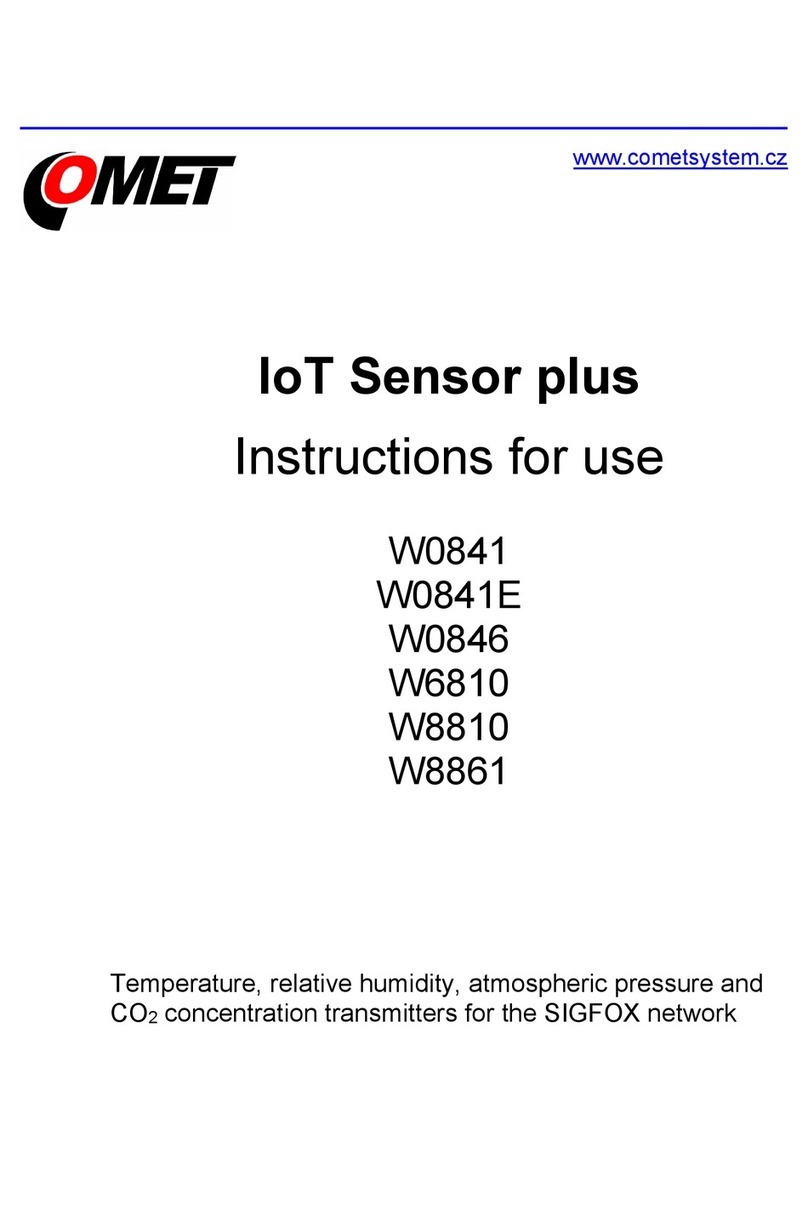Sorel LTDC User manual

Temperature difference controller LTDC
Installation and operating instructions
Read carefully before installation, commissioning and operation

Content
Safety Instructions 4
EU-Conformity 4
General instructions 4
Explanation of Symbols 4
Changes to the Unit 5
Warranty and Liability 5
Disposal and Pollutants 5
Description LTDC 5
About the Controller 5
Specifications 6
Scope of supply 6
Hydraulic Variants 7
Installation 10
Electrical Terminals 10
Wall Installation 11
Electrical Connection 12
Installing the Temperature Sensors 12
Temperature Resistance Table for Pt1000 Sensors 12
Operation 13
Display and Input 13
Commissioning help 14
1. Measurement values 14
2. Statistics 15
Operating hours 15
Heat quantity 15
Graphic overview 15
Error messages 15
Reset / Clear 15
3. Operating mode 16
Automatic 16
Manual 16
Off 16
4. Settings 17
Tmin S1 17
Priority Storage X 17
ΔT Solar Storage X 17
Tmax S2 17
Tmin Storage X 17
Priority temperature 18
Loading time 18
Increase 18
5. Protective Functions 19
System protection 19
Collector protection 19
Recooling 19
Seizing Protection 19
Collector alarm 20
Pressure Monitoring 20
6. Special Functions 20
Program selection 20
Pump settings 20
Signal type 20
Pump 20
Speed control 20
Variant 20
Purging time 21
Sweep time 21
Max. Speed 21
Min. Speed 21
Setpoint 21
Relay functions 21
Solar bypass 21
Solar bypass 22
Variant 22
Bypass sensor 22
Thermostat 22
Tset 22
Hysteresis 22
Thermostat sensor 1 22
Thermostat sensor 2 22
T eco 22
Energy Saving Mode 22
Thermostat enable 22
Cooling 22
Tset 22
Hysteresis 22
Cooling sensor 22
Periods 23
Return flow increase 23
Return flow increase 23
RF Tmin 23
RL Tmax 23
ΔT return flow 23
Return flow sensor 23
Storage sensor 23
Field cooling 23
Field cooling sensor 23
Hys max 23
Hys min 23
Tmax field 23
Anti Legionella 23
Heat transfer 24
Heat transfer 24
Δ T Heat transfer 24
HT Tmax 24
HT Tmin 24
HT-Source 24
HT-Drain 24
Difference 24
Difference 24
Δ T Difference 24
DF-Source 25
Diff. Tmin 25
Diff.-Drain 25
Diff. Tmax 25
Solid fuel boiler 25
Solid fuel boiler Tmin 25
ΔT Solid fuel boiler 25
Solid fuel boiler Tmax 25
Boiler sensor of this function 25
Storage sensor 25
Error messages 25
Error message 25
Pressure monitor 26
Pressure monitor 26
RPS1 / RPS2 26
Pmin 26
Pmax 26
Booster 26
Booster 26
Charge time 26
Parallel operation R1/R2 26
Parallel operation 26
Delay 26
Followup time 26
Always on 26
Heating Circuit 26
Room sensor 27
Room Reference (Night) 27
Room Reference (Day) 27
Periods 27
Heat quantity 27

Flow temperature sensor (X) 27
Return flow sensor 27
Glycol type 27
Glycol percentage 27
Flow rate supply flow (X) 27
Offset ∆T 27
VFS (X) 27
VFS - Position 27
Reference sensor 27
Sensor Calibration 28
Commissioning 28
Factory Settings 28
Time & Date 28
Starting aid 28
Purging time 28
Increase 28
Global radiation sensor 28
Radiation sensor 28
Radiation intensity 29
Blocking time 29
Daylight saving time 29
Eco Display Mode 29
Temperature unit 29
Network 29
Access Control 29
Ethernet 29
CAN bus ID 29
7. Menu Lock 30
8. Service values 30
9. Language 30
Malfunctions/Maintenance 31
Additional Information 32
External relay at signal output V(X) (0-10V / PWM) 32
CAN bus 32
Appendix 33
Pump 33
Profile 33
Output Signal 33
PWM / 0-10V off 33
PWM / 0-10V on 33
PWM / 0-10V max. 33
Speed when „On“ 33
Example for pump settings 33
Technical data PWM and 0-10V 34
Show signal 34
Tips 35

Safety Instructions
EU-Conformity
By affixing the CE mark to the unit the manufacturer declares that theLTDC conforms to the following relevant safety regulations:
lEU low voltage directive 2014/35/EU
lEU electromagnetic compatibility directive 2014/30/EU
conforms. Conformity has been verified and the corresponding documentation and the EU declaration of conformity are kept on
file by the manufacturer.
General instructions
Please read carefully!
These installation and operating instructions contain basic instructions and important information regarding safety, installation,
commissioning, maintenance and the optimal use of the unit. Therefore these instructions must be read and understood com-
pletely by the installation technician/specialist and by the system user before installation, commissioning and operation of the
unit.
The device is an automatic, electric Solar multi-circuit controller for/in solar or heating system and similar applications. Install the
device only in dry rooms and under environmental conditions as described under "Technical Data".
The valid accident prevention regulations, VDE regulations, the regulations of the local power utility, the applicable DIN-EN stand-
ards and the installation and operating instruction of the additional system components must also be observed.
Under no circumstances does the unit replace any safety devices to be provided by the customer!
Installation, electrical connection, commissioning and maintenance of the device may only be carried out by an appropriately
trained specialist. Users: Make sure that the specialist gives you detailed information on the function and operation of the unit.
Always keep these instructions in the vicinity of the unit.
The manufacturer does not take over any liability for damage caused through improper usage or non-compliance of this manual!
Explanation of Symbols
Danger
Failure to observe these instructions can result in electrocution.
Danger
Failure to observe these instructions can result in serious damage to health such as scalding or life-threatening
injuries.
Caution
Failure to observe these instructions can result in destruction of the unit or the system, or environmental dam-
age.
Caution
Information which is especially importation for the function and optimal use of the unit and the system.
4

Changes to the Unit
lChanges, additions to or conversion of the unit are not permitted without written permission from the man-
ufacturer.
lIt is likewise forbidden to install additional components that have not been tested together with the unit.
lIf it becomes clear that safe operation of the unit is no longer possible, for example because of damage to the
housing, turn the Unit off immediately.
lAny parts of the unit or accessories that are not in perfect condition must be exchanged immediately.
lUse only original spare parts and accessories from the manufacturer.
lMarkings made on the unit at the factory must not be altered, removed or made illegible.
lOnly the settings described in these instructions may be set using the Unit.
Changes to the unit can compromise the safety and function of the unit or the entire system.
Warranty and Liability
The unit has been manufactured and tested with regard to high quality and safety requirements. The unit is subject to the stat-
utory guarantee period of two years from the date of sale. The warranty and liability shall not include, however, any injury to per-
sons or material damage that is attributable to one or more of the following causes:
lFailure to observe these installation and operating instructions.
lImproper installation, commissioning, maintenance and operation.
lImproperly executed repairs.
lUnauthorized structural changes to the unit.
lUse of the device for other than its intended purpose.
lOperation above or below the limit values listed in the ‚Specifications‘ section.
lForce majeure.
Disposal and Pollutants
The unit conforms to the European RoHS 2011/65/EU for the restriction of the use of certain hazardous substances in electrical
and electronic equipment.
Under no circumstances may the device be disposed of with the normal household waste. Dispose of the unit only at
appropriate collection points or ship it back to the seller or manufacturer.
Description LTDC
About the Controller
The Solar multi-circuit controller LTDC facilitates efficient use and function control of your solar or heating system possible while
its handling is intuitive. After every input step the suitable functions are matched to the keys and explained in a text above. In the
menu 'measurement values and settings' are help text and graphics in addition to key words.
The LTDC can be used for the various system variants.
Important characteristics of the LTDC are:
lDepiction of graphics and texts using a lit display.
lSimple viewing of the current measurement values.
lStatistics and system monitoring by means of statistical graphics
lExtensive setting menus with explanations.
lMenu block can be activated to prevent unintentional setting changes.
lResetting to previously selected values or factory settings.
5

Specifications
Electrical specifications:
Power supply 100 - 240VAC, 50 - 60 Hz
Power consumption /
standby
0,5 W - 2,5 W/ 0,5 W
Internal fuse 1 1
Protection category IP40
Protection class / overvoltage category II / II
Inputs/Outputs Measuring range
Sensor inputs 6 PT1000 -40 °C ... 300 °C
Sensor inputs VFS / RPS 2 Grundfos Direct Sensor
or SIKA Vortex Flow
Sensor
0°C-100°C | 2...40 l/min
VFS type in l/min 1 - 12, 2 - 40, 5 - 100, 10 - 200
RPS type in bar 0 - 0.6, 0 - 1, 0 - 1.6, 0 - 2.5, 0 - 4, 0 - 6, 0 - 10
VVX 15 in l/min 2 - 40
VVX 20 in l/min 5 - 80
VVX 25 in l/min 7 - 150
Version 1 Version 2 Version 3 Version 4
Pt 1000 Measuring range -40 °C ... 110 °C 5 5 6 6
Sensor input VFS / RPS 0 0 2 2
mechanical relay as alternating contact (R)
460VA for AC1 / 460W for AC3
1 1 1 1
electronic relay min. 5W ... max. 120W for AC3 0 2 0 2
0-10V output (Tolerance +/- 10%) 10 kΩ load V1 V1 V1-V2 V1-V2
PWM output freq. 1 kHz, level 10 V V1 V1 V1-V2 V1-V2
Max. cable length
Collector sensor S1 <30m
other Pt1000 sensor <10m
VFS/RPS sensors <3m
CAN <3m; at> = 3m, a shielded twisted pair cable must be used. Isolate shield-
ing and connect it to the protective conductor of only one of the devices.
0-10V/PWM <3m
mechanical relay <10m
Interface
Fieldbus CAN
Permissible Ambient Conditions
for controller operation 0 °C - 40 °C, max. 85 % rel. humidity at 25 °C
for transport/storage 0 °C - 60 °C, no moisture condensation permitted
Other Specifications and Dimensions
Housing design 2-part, ABS plastic
Installation methods Wall installation, optionally panel installation
Overall dimensions 163 mm x 110 mm x 52 mm
Aperture installation dimen-
sions
157 mm x 106 mm x 31 mm
Display Fully graphical display, 128 x 64 dots
Light diode multicolour
Real Time Clock RTC with 24 hour power reserve
Operation 4 entry keys
Scope of supply
lSolar multi-circuit controller LTDC
l3 screws 3,5 x 35 mm and 3 plugs 6 mm for wall installation.
l6 strain relief clips with 12 screws, replacement fuse 1x T2A / 250 V
lLTDC Installation and operating instructions
6

Optionally contained depending on design/order:
lCAN Bus Accessories: Datalogger with Ethernet connection
lExternal relay for V1 / V2: Switching relay 250 VAC 6W, control voltage 9 - 12 VDC
Hydraulic Variants
The following illustrations should be regarded only as schematic representations of the respective hydraulic systems
and do not claim to be complete. Under no circumstances should the controller replace any safety devices. Depend-
ing on the specific application, additional system and safety components such as check valves, non-return valves,
safety temperature limiters, scalding protectors, etc., may be required.
Solar with storage Solar with pool Solid fuel boiler with storage
Storage transfer Heating circuit return flow increase Thermostat
Universal Delta T Shutoff valve Solar with pool and heat exchanger
Solar with thermostat (auxiliary heat-
ing)
Solar with two-zone storage Solar with heating circuit
Solar with bypass Solar with heat exchanger Solar with 2 collector surfaces
7

Solar with 2 collector surfaces and 2
pumps
Solar with 2 storages and switching
valve
Solar with 2 storages and 2 pumps
Solar with storage transfer Solar with pool and heat exchanger Solar with thermostat and switching
valve
Solar and solid-fuel boiler Solar with cooling 1 (collector cooling) Solar with cooling 2 (collector cooling)
Solar with cooling 3 (collector cool-
ing)
Solar with heat exchanger, two-zone
storage and valve
Solar with heat exchanger, 2
storages and valve
Solar with pool, storage and heat
exchanger
Solar with storage and solid-fuel
boiler and S4
2x Solar
Solar with thermostat and heat trans- Solar with thermostat and return flow Solar with 2 collector surfaces,
8

fer increase 2 storages and 2 valves
Solar with 2 collector surfaces, 2 stor-
ages and 2 pumps
Solar with pool, storage and heat
exchanger Solar with 3 storages and 3 pumps
Solar with 3 storages and 3 switching
valve
Solar with heat exchanger Solar with heat exchanger, two-zone
storage and valve
Solar with heat exchanger, 2 stor-
ages and valve
Solar with 2 collector surfaces, heat
exchanger and 3 pumps
Solar with 2 collector surfaces,
heat exchanger and 2 pumps
9

Installation
Electrical Terminals
Low voltage
max. 12 VAC / DC
Mains voltages
230 VAC 50 - 60 Hz
On the control board
LTDC Version V3 + V4:
VFS1 Grundfos Direct Sensor
VFS2 Grundfos Direct Sensor
LTDC Version V1 + V4:
CAN CAN bus connection (1=high,2=low)
CAN CAN bus connection (1=high,2=low)
Terminal: Connection for:
S1 Temperature Sensor 1
S2 Temperature Sensor 2
S3 Temperature Sensor 3
S4 Temperature Sensor 4
S5 Temperature Sensor 5
V1 speed controlled output for 0-10V / PWM high-effi-
ciency pumps
LTDC Version V3 + V4:
V2 0-10V / PWM signal output e.g. for con-
trolling high-efficiency pumps
S6 Temperature Sensor 6
+ 12V Power supply
The connection of the ground wire is made at the lower gray ter-
minal block.
Terminal: Connection for:
N Neutral conductor N
L Network outer conductor L
R1 Relays 1
R2 Relays 2
R3| Relays 3|
R3 Relays 3
The neutral conductor N must be connected to the N ter-
minal block.
The PE protective conductor must be connected to the
PE metal terminal block!
In high-efficiency pumps with 0-10V / PWM signal input,
the power supply must go through the corresponding
relay (V1 -> R1, R2 -> V2), because the relay turns on
and off together with the control signals.
At R3I are permanently 230v when the relay is inactive. Wrong wiring can damage the connected components.
10

Wall Installation
1. Unscrew cover screw completely.
2. Carefully pull upper part of housing
from lower part. During the removal,
the brackets are released as well.
3. Set upper part of housing aside Do not
touch the electronics.
4. Hold the lower part of the housing up
to the selected position and mark the
three mounting holes. Make sure that
the wall surface is as even as possible
so that the housing does not become
distorted when screwed on.
5. Using a drill and size 6 bit, drill three
holes at the points marked on the wall
and push in the plugs.
6. Insert the upper screw and screw it in
slightly.
7. Fit the upper part of the housing and
insert the other two screws.
8. Align the housing and tighten the three
screws.
1. open terminal cover.
2. Strip lines a max. of 55 mm, assemble
the strain reliefs, strip wire ends 8-9
mm (figure 1)
3. Open clamps with a fitting screwdriver
(figure 2) and connect electrical system
to the controller.
4. Suspend clip room cover again and
close with the screw.
5. Turn on mains supply and operate the
controller.
11

Electrical Connection
Before working on the unit, switch off the power supply and secure it against being switched on again! Check that there
is no power flowing! Electrical connections may only be made by a specialist and in compliance with the applicable
regulations. The unit may not be put into operation if there is visible damage to the housing, e.g. cracks.
The unit may not be accessible from behind.
Low-voltage cables such as temperature sensor cables must be routed separately from mains voltage cables. Feed
temperature sensor cables only into the left-hand side of the unit, and mains voltage cables only into the right-hand
side.
The customer must provide an all-pole disconnecting device, e.g. an emergency heating switch.
The cables being connected to the unit must not be stripped by more than 55 mm, and the cable jacket must reach into
the housing just to the other side of the strain relief.
Installing the Temperature Sensors
The controller operates with Pt1000 temperature sensors which are accurate to 1 °C, ensuring optimal control of system func-
tions.
If desired, the sensor cables can be extended to a maximum of 30 m using a cable with a cross-section of at least
0.75 mm². Ensure there is no contact resistance! Position the sensor precisely in the area to be measured! Only use
immersion, pipe-mounted or flat-mounted sensors suitable for the specific area of application with the appropriate
permissible temperature range.
Low-voltage cables such as temperature sensor cables must be routed separately from mains voltage cables. Feed
temperature sensor cables only into the left-hand side of the unit, and mains voltage cables only into the right-hand
side.
Temperature Resistance Table for Pt1000 Sensors
°C -20 -10 0 10 20 30 40 50 60 70 80 90 100
Ω 922 961 1000 1039 1077 1116 1155 1194 1232 1270 1308 1347 1385
12

Operation
Display and Input
Pump (rotates when active)
Valve (direction of flow black)
Collector
Storage / buffer
Solid fuel boiler
Pool
Thermostat On/Off
Temperature Sensors
Heat exchanger
Warning/Error message
New information available
Further symbols can be found in the special
functions
The display‘s (1), extensive text and graphical mode,
enables simple, almost self-explanatory, operation of the
controller.
The LED (2) lights up green when a relay is switched on.
The LED (2) lights up red when operating mode ‚Off‘ is set.
The LED (2) flashes quickly red when an error is present.
Entries are made using 4 keys (3+4), to which contextual
functions are assigned. The ‚esc‘ key (3) is used to cancel
an entry or to exit a menu. If applicable, a request for con-
firmation appears to save the made changes.
The function of the other 3 keys (4) is shown in the display
right above the keys. The right-hand key generally has a con-
firmation and selection function.
The graphics mode appears if no key is pressed for 2
minutes or after exiting the main menu with ‘esc’.
The temperature overview appears when you press the.
left button. Tapping the button again leads back to
The graphic overview.
Hitting the "esc" key in the graphics mode takes you directly
to the main menu.
Examples for key settings:
+/- Increase / decrease values
▼/▲ Scroll down / up menu
Yes/No agree / reject
About further information
Back to the previous display
Ok Confirm selection
Confirm Confirm setting
13

Commissioning help
1. Set language and time
2. Commissioning help / setup wizard
a) select or
b) skip.
The setup wizard guides through the necessary basic settings in the cor-
rect order. Each parameter is explained in the control
display. Pressing the „esc“ key takes you back to the previous setting.
b) With free commissioning the settings should be made in the following
order:
lMenu 9. Language
lmenu 3. Time, Date and Operating Times.
lmenu 4. Heating Circuit Settings, all values.
lmenu 5. Protection Functions (if any adjustments neces-
sary).
lmenu 6. Special Functions (if any adjustments neces-
sary).
3. In menu operating mode "3.2. Manual”, test the witch outputs with the
consumers connected and check the sensor values for plausibility. Then
set to automatic mode.see " Manual " on page 16
The setup wizard can be accessed in menu 6.13. at any time.
Consider the explanations for the individual parameters on the following pages and check if further settings are
necessary for your application.
1. Measurement values
Serve to display the current measured temperatures.
If ‚error‘ appears on the display instead of the measurement
value, there may be a defective or incorrect temperature sensor.
If the cables are too long or the sensors are not well-placed, small
deviations in the measurement values may occur. In this case, the
display values can be compensated by adjustments in the con-
troller - see ‚Sensor calibration‘. The selected program, con-
nected sensors and the specific model design determine which
measurement values are displayed.
14

2. Statistics
Serve for function control and long-term monitoring of the system.
For system data statistics it is essential for the time to be set
accurately on the controller. Please note that the clock con-
tinues to run for about 24 hours if the mains voltage is inter-
rupted, and afterward must be reset. Improper operation or an
incorrect time may result in data being cleared, recorded incor-
rectly or overwritten. The manufacturer accepts no liability for
the recorded data!
Operating hours
Display of the operating hours of the consumers connected to the controller (for example, solar pumps, valves etc.) whereby dif-
ferent time ranges (day-years) are available!
Heat quantity
Display of the consumed heat quantity form the system in kWh.
Graphic overview
This results in a clear illustration of the data as a bar graph. Different time ranges are available for comparison. You can page
through with the two left keys.
Error messages
Display of the last 15 errors in the system with indication of date and time.
Reset / Clear
Resetting and clearing the selected statistics. Selecting ‚all statistics‘ clears everything except the error log.
15

3. Operating mode
Automatic
The automatic mode is the normal mode of the controller. A correct controller function under consideration of the current tem-
peratures and the set parameters is only present in automatic mode! After an interruption of the mains voltage, the controller auto-
matically returns to the last operating mode selected.
Manual
In ‚Manual‘ mode, the individual relay outputs and the connected consumers can be checked for proper functioning and correct
assignment.
The operating mode ‚Manual‘ may only be used by specialists for brief function tests, e.g. during commissioning! Func-
tion in manual mode: The relays and thus the connected consumers are switched on and off by pressing a key, with no
regard to the current temperatures and set parameters. At the same time, the current measurement values of tem-
perature sensors are also shown in the display for the purposes of function control.
Off
If the operating mode “off” is enabled, all control functions are turned off. The measured temperatures are displayed for
the overview.
16

4. Settings
By no means does the controller replace the safety appliances on
site!
Tmin S1
Enable/start temperature at sensor 1:
If this value on the sensor 1 (collector sensor) is exceeded and the other conditions are not fulfilled, the controller will turn on the
affiliated pump or the valve. If the temperature on the sensor 1 falls 5 °C below this value, the pump or the valve will be turned off
again.
Priority Storage X
Priority of storages in a multiple storage system. This determines the order, in which the storages are charged. If the same priority
is set for 2 storages, the charging is not switched over until charging the active storage is not possible anymore.
Example: if several storages or storage areas in your system are integrated, you can specify a priority for each sensor of the stor-
age or the storage area. The "X" in the menu item priority S(X) indicates the sensor of the respective storage or storage area.
The priority for the first storage is thus set under priority S2 and for the 2. storage under priority S3.
ΔT Solar Storage X
Switch-on/switch-off temperature difference for sensor X: If the temperature difference ΔT solar between the reference sensors is
exceeded and the other conditions are fulfilled, the controller will turn on the pump/valve on the corresponding relay. If the tem-
perature difference falls to ΔT Off, the pump/valve will be turned off again.
If the set temperature difference is too small, this may lead to ineffective operation depending on the system and
sensor positioning. For speed regulation (see " Speed control " on page 20), special switch conditions apply!
Example: if several storages or storage areas in your system are integrated, you can specify ΔT for each sensor of the storage or
the storage area. The "X" in the menu item ΔT solar S(X) indicates the sensor of the respective storage or storage area.
ΔT solar for the first storage is thus set under ΔT solar S2 and for the 2. storage under ΔT solar S3.
Tmax S2
Switch off temperature at sensor 2:
If this value is exceeded on the sensor 2, the controller turn off the affiliated pump or the valve. If this value on the sensor 2 is
undershot and the other conditions are fulfilled, the controller will turn on the pump or the valve.
Temperature values which are set too high can lead to scalding or damage to the system. Scalding protection must be
provided by the customer!
In multiple storage systems, if the shut-down temperature S2 is exceeded, a downstream installed storage or storage area is
switched to.
Tmin Storage X
Switch-off temperature at sensor X at multiple storage systems
If this value is exceeded at sensor X then the controller switches the associated pump and/or valve off. If sensor 3 falls below this
value again and the other conditions are also met, then the controller switches the pump and/or valve on again.
Temperature values which are set too high can lead to scalding or damage to the system. Scalding protection must be
provided by the customer!
In multiple storage systems, if the shut-down temperature S(X) is exceeded, a downstream installed storage or storage area is
switched to.
17

Example: if several storages or storage areas in your system are integrated, you can specify a priority for each sensor of the stor-
age or the storage area. The "X" in the menu item priority S(X) indicates the sensor of the respective storage or storage area.
The priority for the first storage is thus set under priority S2 and for the 2. storage under priority S3.
Priority temperature
Temperature threshold for absolute priority charge. In systems with two storage tanks charging of the lower-priority storage tank
will never take place until this temperature at sensor of the higher-priority storage tank is exceeded.
Loading time
Interruption of charging into the lower priority storage. The charging of the lower-priority storage is interrupted after the settable
time in order to check whether the collector has reached a temperature level that allows charging in the higher- priority storage. If
so, the priority storage tank is charged. If not, the increase is measured (see " Increase " on page 18), to check if charging of the
priority storage will be possible shortly.
Increase
Extension of the charging pause due to temperature increase. For precise setting of the charging priorities for systems with mul-
tiple storage tanks, the necessary temperature increase of the collector at which the interruption of the charging into the lower-pri-
ority storage tank is extended by one minute is set here. The interruption is extended because the temperature increase of the
collector is expected to enable charging in the higher-priority storage tank soon. As soon as ΔT conditions are met, the priority
storage tank is charged.
If the rise in temperature falls below the set value, then the charging of the lower-priority storage tank is enabled again.
18

5. Protective Functions
The 'Protective functions‘ can be used by specialists to activate and set vari-
ous protective functions.
By no means does the controller replace the safety appliances on
site!
System protection
Priority protection function
The system protection should prevent an overheating of the components installed in the system through the forced shut down of
the solar circulation pump. If the value “AS Ton” on the collector has been exceeded for 1 Min. the pump will be turned off and not
turn on again in order to protect the collector, for example, from steam. The pump is turned on again when the value “AS Toff” on
the collector has not been met.
With the system protection (on), there are increased standstill temperatures in the solar collector and therefore an
increased pressure in the system. The operating manuals from the system components must be observed.
Collector protection
Priority protection function
The collector protection prevents the collector from overheating. A forced switching of the pump makes sure that the collector is
cooled through the storage. If the value “KS Ton” is exceeded on the collector, the pump will be turned on in order to cool the col-
lector. The pump is shut down if the value “KS Toff” on the collector is not met or the value “KS Tmax Sp.” on the storage or KS SB
Max on the pool is exceeded.
System protection has priority over collector protection! Even if the switch requirements for the collector protection are
present, the solar circulation pump is turned off once “AS T on” is reached. Normally the values from the system pro-
tection (depending on the maximum temperature of the storage or other components) are higher than the collector pro-
tection.
Recooling
In the system hydraulics with solar, excess energy is guided from the storage back to the collector with an activated return cooling
function. This only occurs if the temperature in the storage is greater than the value “Return cooling Tref” and the collector is at
least 20 °C colder than the storage and until the storage temperature has fallen below the value “Return cooling Tref”. For muti-
storage systems, the return cooling applies to all storage.
Energy is lost through the collector through this function! The recooling should only be activated in cases of exception,
with low heat acceptance, for example, during vacation.
Frost Protection
A 2-level frost protection function can be activated. In level 1, the controller turns on the pump every hour for 1 minute if the col-
lector temperature is below the set value “Frost Level 1”. If the collector temperature continues to decrease to the set value “Frost
Level 2”, the controller will turn on the pump without disruption. If the collector temperature exceeds the value “Frost level 2” by 2
°C, the pump will turn off again.
Energy is lost through the collector through this function! It is normally not activated for solar systems with antifreeze.
The operating manuals from the other system components must be observed.
Seizing Protection
If the anti-seizing protection is activated, the controller switches the heat pump and the mixer on/off at 12:00 noon or weekly on
Sundays at 12:00 for 5 seconds to prevent seizing of the pump/valve after long periods of inactivity.
19

Collector alarm
If this temperature at the collector sensor is exceeded when the solar pump is turned on, a warning or error notification is
triggered. There is a corresponding warning in the display.
Pressure Monitoring
In this menu, the system pressure monitoring can be activated through a direct sensor. Once the set pressure conditions are
exceeded, a message is generated and the LED flashes red.
6. Special Functions
Used to set basic items and expanded functions.
The settings in this menu should only be changed by a specialist.
Program selection
Here the hydraulic variation fitting to the respective use case is selected and set.
The program selection normally occurs only once during the first entry into service by a specialist. An incorrect pro-
gram selection may lead to unpredictable errors.
Pump settings
Settings from the 0-10V or the PWM pump can be made in this menu.
When this menu is selected, you may receive a request to save the speed settings.
Signal type
The type of device to be controlled is set here.
0-10V: Controlled by a 0-10V signal.
PWM: Control by means of a PWM signal.
Pump
In this menu, the preset profiles for the pump can be selected or under “manual” all settings can be done personally. The settings
can still be changed after a profile has been selected.
Speed control
If the speed control is activated, itLTDC offers the possibility through a special internal electronic system to change the speed of
pumps depending on the process. The relay R1, R2 and the Pwm and 0-10V outputs can work with the speed controlled.
This function should only be activated by a technician. Depending on the pump being used and the pump level, the
minimum speed may not be set too small, because the pump or the system may be damaged. The specifications from
the affected manufacturer must be observed for this! When in doubt, the min. speed and the pump level should be set
too high instead of too low.
Variant
The following speed variants are available here:
Off: There is no speed regulation. The connected pump is only turned on or off with full speed.
Mode M1: The controller changes to the set max. speed after the purging time. If the temperature difference ∆T between the ref-
erence sensors is below the set switch on temperature difference ∆T R1, the speed will be reduced. If the temperature difference
between the reference sensors is above the set switch on temperature difference ∆T R1, the speed will be increased. If the con-
troller has decreased the speed of the pump to the smallest level and the ∆T between the reference sensors is still only ∆Toff, the
pump will be turned off.
20
Table of contents
Other Sorel Temperature Controllers manuals
Popular Temperature Controllers manuals by other brands
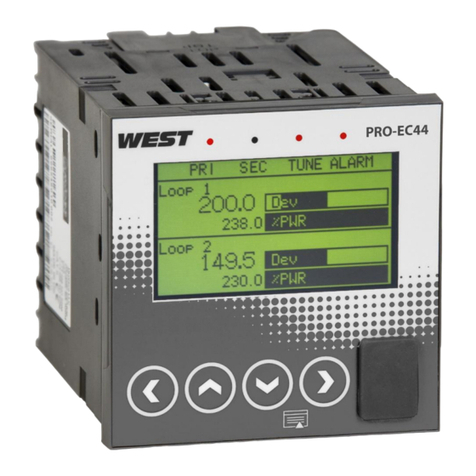
West Control Solutions
West Control Solutions Pro-EC44 user guide
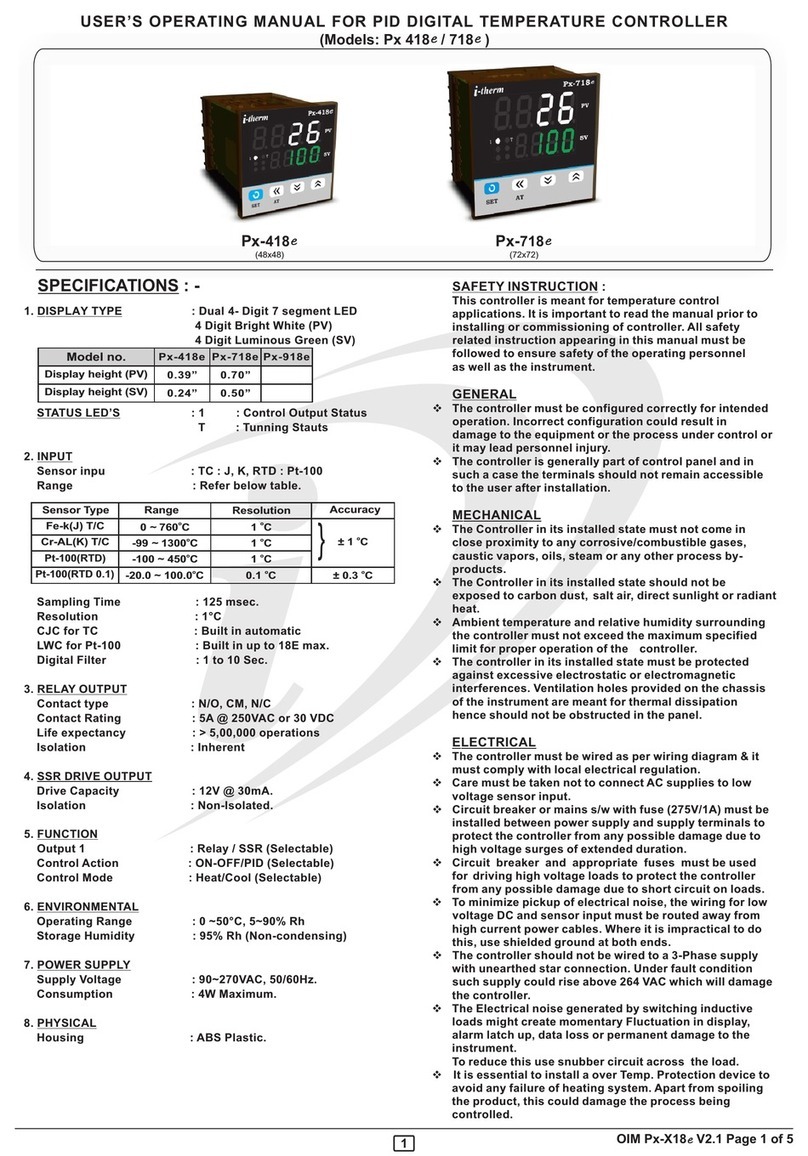
i-therm
i-therm Px-418e User's operating manual
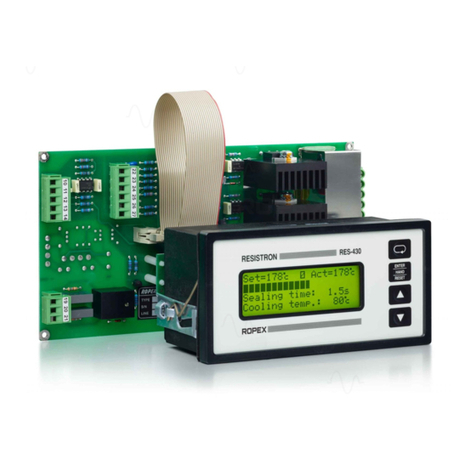
Ropex
Ropex Resistron RES-430 Series operating instructions
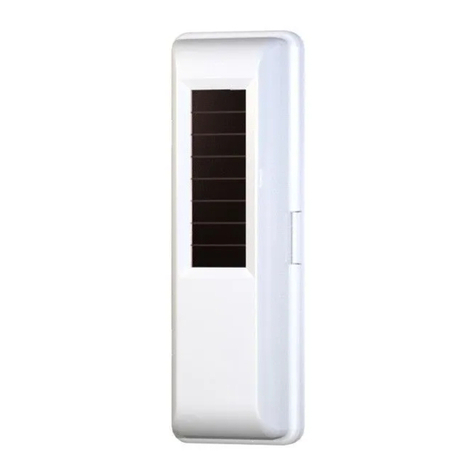
EnOcean
EnOcean Trio2Sys O2LINE 10020057 Series Installation and operating manual
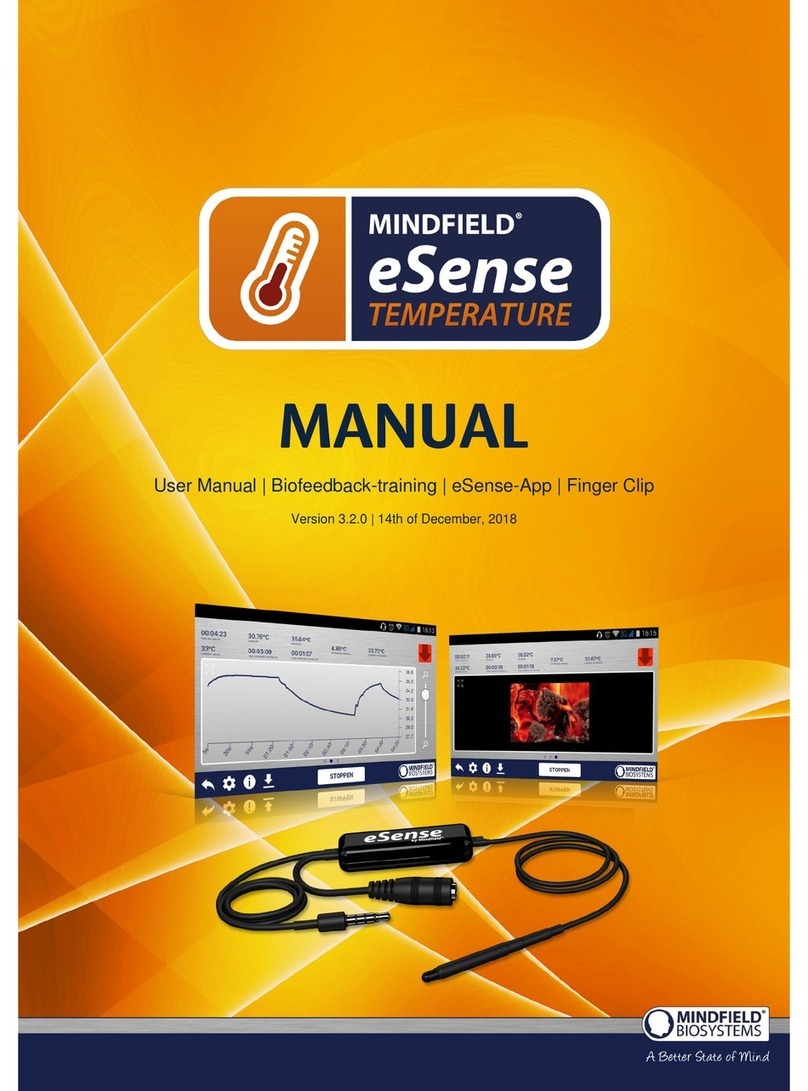
Mindfield
Mindfield eSense user manual
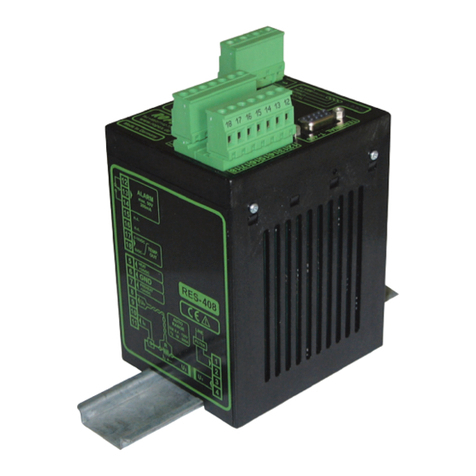
Ropex
Ropex RESISTRON RES-408 operating instructions
